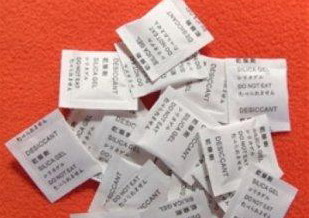Desiccant classification and application
2025-08-23 12:29:48
 **Desiccant Classification and Application**
Desiccants, also known as drying agents, are widely used for moisture control and to prevent mold and corrosion. Their main function is to absorb moisture from the surrounding air, helping to maintain a dry environment. The working principle of desiccants involves either physical adsorption or chemical absorption. Physical desiccants trap water molecules within their structure, while chemical desiccants react with water, altering their chemical composition to form new compounds. Based on this mechanism, desiccants can be broadly categorized into physical adsorption desiccants and chemical adsorption desiccants.
**Physical Adsorption Desiccants**
These types of desiccants work by physically capturing water molecules through their porous structures. Common examples include silica gel, activated alumina, molecular sieves, activated carbon, bone charcoal, mineral desiccants, and activated clay. They are often used in applications where a reversible drying process is needed, as they can release the absorbed moisture under certain conditions.
**Chemical Adsorption Desiccants**
Chemical desiccants, on the other hand, react with water molecules, causing a permanent change in their chemical structure. Examples include lime-based desiccants, magnesium chloride, calcium chloride, soda lime, phosphorus pentoxide, and silicic acid. These are typically used in more specialized environments where a high level of drying is required.
**Applications of Physical Adsorption Desiccants**
1. **Bottled Medicines and Food**: Used to keep products dry and prevent microbial growth.
2. **Packaging Desiccants**: Often included in packaging to protect items from humidity.
3. **General Use**: Placed inside electronic devices, leather goods, clothing, food containers, and household appliances to prevent rust, mildew, and damage caused by moisture.
**Applications of Chemical Adsorption Desiccants**
1. **Acid Desiccants**: Such as phosphorus pentoxide, which is used to dry acidic or neutral gases. However, it cannot be used to dry gases like hydrogen sulfide or hydrogen bromide, as they are strong reducing agents.
2. **Neutral Desiccants**: Anhydrous copper sulfate and calcium chloride are commonly used to dry general gases. However, calcium chloride should not be used to dry ammonia.
3. **Alkaline Desiccants**: Soda lime, quicklime, and solid sodium hydroxide are effective for drying neutral or alkaline gases.
In summary, desiccants play a crucial role in maintaining product quality and longevity across various industries. Choosing the right type of desiccant depends on the specific application, environmental conditions, and the nature of the substances being protected. Whether you're storing electronics, pharmaceuticals, or food products, understanding the differences between physical and chemical desiccants can help you make an informed decision for optimal performance.
**Desiccant Classification and Application**
Desiccants, also known as drying agents, are widely used for moisture control and to prevent mold and corrosion. Their main function is to absorb moisture from the surrounding air, helping to maintain a dry environment. The working principle of desiccants involves either physical adsorption or chemical absorption. Physical desiccants trap water molecules within their structure, while chemical desiccants react with water, altering their chemical composition to form new compounds. Based on this mechanism, desiccants can be broadly categorized into physical adsorption desiccants and chemical adsorption desiccants.
**Physical Adsorption Desiccants**
These types of desiccants work by physically capturing water molecules through their porous structures. Common examples include silica gel, activated alumina, molecular sieves, activated carbon, bone charcoal, mineral desiccants, and activated clay. They are often used in applications where a reversible drying process is needed, as they can release the absorbed moisture under certain conditions.
**Chemical Adsorption Desiccants**
Chemical desiccants, on the other hand, react with water molecules, causing a permanent change in their chemical structure. Examples include lime-based desiccants, magnesium chloride, calcium chloride, soda lime, phosphorus pentoxide, and silicic acid. These are typically used in more specialized environments where a high level of drying is required.
**Applications of Physical Adsorption Desiccants**
1. **Bottled Medicines and Food**: Used to keep products dry and prevent microbial growth.
2. **Packaging Desiccants**: Often included in packaging to protect items from humidity.
3. **General Use**: Placed inside electronic devices, leather goods, clothing, food containers, and household appliances to prevent rust, mildew, and damage caused by moisture.
**Applications of Chemical Adsorption Desiccants**
1. **Acid Desiccants**: Such as phosphorus pentoxide, which is used to dry acidic or neutral gases. However, it cannot be used to dry gases like hydrogen sulfide or hydrogen bromide, as they are strong reducing agents.
2. **Neutral Desiccants**: Anhydrous copper sulfate and calcium chloride are commonly used to dry general gases. However, calcium chloride should not be used to dry ammonia.
3. **Alkaline Desiccants**: Soda lime, quicklime, and solid sodium hydroxide are effective for drying neutral or alkaline gases.
In summary, desiccants play a crucial role in maintaining product quality and longevity across various industries. Choosing the right type of desiccant depends on the specific application, environmental conditions, and the nature of the substances being protected. Whether you're storing electronics, pharmaceuticals, or food products, understanding the differences between physical and chemical desiccants can help you make an informed decision for optimal performance.Thin Section Bearings,Miniature Ball Bearings,Precision Ball Bearings,
Yuyao Shuguang stainless steel bearing Co., LTD , https://www.shuguangbearing.com